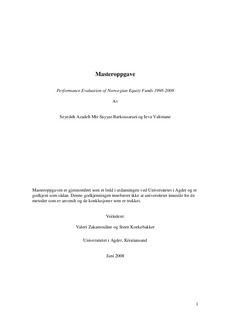| dc.description.abstract | The purpose of this thesis is to evaluate the performance of Norwegian equity funds
during the period from 1998 to 2008. We have identified the best and the worst
performing funds during the period based on five performance measures: Sharpe ratio,
Treynor ratio, Jensen’s Alpha, Appraisal ratio and Modigliani and Modigliani measure.
The analysis focuses on the funds’ performance in the form of risk-adjusted return. We
compare the performances of the funds, and investigate whether they achieve a higher
risk-adjusted excess return than the market benchmark, as well we check if equity funds
hold the risk profile they claim to have in their prospects.
The performance evaluation methods used to rank the mutual funds have given results
with strong positive correlation. The funds with the best performance according to the
majority of the performance measures were Alfred Berg GAMBAK, ODIN Norge and
Storebrand Verdi.
The results show that none of the 36 funds generate a significant positive risk-adjusted
excess return above the market. Most of the funds’ risk profiles were strikingly low as
compared to the market benchmark, despite the fact that they claim to have high risk
portfolio. We also observed that individual funds within the same management company
had a similar risk profile.
Further we examine funds’ performance persistence and funds’ stock picking and market
timing ability. We come to conclusion that there is no performance persistence during the
observation period among Norwegian equity funds. When it comes to market timing
ability we identify 1 fund out of 36 that exhibits positive market timing ability for both
tests we employ. We conclude that market timing ability is rare and we can confirm the
validity of Efficient Market Hypothesis in Norwegian stock market.
We have identified that funds of larger management companies did, on average, by 20%
better than funds from companies whose assets under management did not exceed 15 bn
NOK.
4
Finaly, we investigate whether change in ownership of management company has an
effect on fund performance, we concentrate especially on acquisition of stand-alone
companies by larger financial groups. We conclude that change in ownership has an
impact on funds’ performance and it seems to have the same effect (positive or negative)
on all the acquired company’s funds. However, we do not find any evidence that
independent stand-alone companies performance tend to deteriorate after being bought by
big financial groups. We find that two companies did improve their results while the
performance of other two deteriorated after acquisition. | en |
